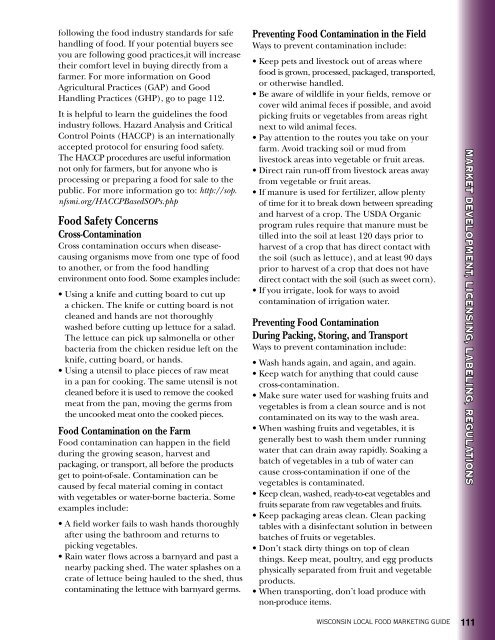Licensing, labeling and regulation requirements in Wisconsin
Licensing, labeling and regulation requirements in Wisconsin
Licensing, labeling and regulation requirements in Wisconsin
You also want an ePaper? Increase the reach of your titles
YUMPU automatically turns print PDFs into web optimized ePapers that Google loves.
follow<strong>in</strong>g the food <strong>in</strong>dustry st<strong>and</strong>ards for safe<br />
h<strong>and</strong>l<strong>in</strong>g of food. If your potential buyers see<br />
you are follow<strong>in</strong>g good practices,it will <strong>in</strong>crease<br />
their comfort level <strong>in</strong> buy<strong>in</strong>g directly from a<br />
farmer. For more <strong>in</strong>formation on Good<br />
Agricultural Practices (GAP) <strong>and</strong> Good<br />
H<strong>and</strong>l<strong>in</strong>g Practices (GHP), go to page 112.<br />
It is helpful to learn the guidel<strong>in</strong>es the food<br />
<strong>in</strong>dustry follows. Hazard Analysis <strong>and</strong> Critical<br />
Control Po<strong>in</strong>ts (HACCP) is an <strong>in</strong>ternationally<br />
accepted protocol for ensur<strong>in</strong>g food safety.<br />
The HACCP procedures are useful <strong>in</strong>formation<br />
not only for farmers, but for anyone who is<br />
process<strong>in</strong>g or prepar<strong>in</strong>g a food for sale to the<br />
public. For more <strong>in</strong>formation go to: http://sop.<br />
nfsmi.org/HACCPBasedSOPs.php<br />
Food Safety Concerns<br />
Cross-Contam<strong>in</strong>ation<br />
Cross contam<strong>in</strong>ation occurs when diseasecaus<strong>in</strong>g<br />
organisms move from one type of food<br />
to another, or from the food h<strong>and</strong>l<strong>in</strong>g<br />
environment onto food. Some examples <strong>in</strong>clude:<br />
• Us<strong>in</strong>g a knife <strong>and</strong> cutt<strong>in</strong>g board to cut up<br />
a chicken. The knife or cutt<strong>in</strong>g board is not<br />
cleaned <strong>and</strong> h<strong>and</strong>s are not thoroughly<br />
washed before cutt<strong>in</strong>g up lettuce for a salad.<br />
The lettuce can pick up salmonella or other<br />
bacteria from the chicken residue left on the<br />
knife, cutt<strong>in</strong>g board, or h<strong>and</strong>s.<br />
• Us<strong>in</strong>g a utensil to place pieces of raw meat<br />
<strong>in</strong> a pan for cook<strong>in</strong>g. The same utensil is not<br />
cleaned before it is used to remove the cooked<br />
meat from the pan, mov<strong>in</strong>g the germs from<br />
the uncooked meat onto the cooked pieces.<br />
Food Contam<strong>in</strong>ation on the Farm<br />
Food contam<strong>in</strong>ation can happen <strong>in</strong> the field<br />
dur<strong>in</strong>g the grow<strong>in</strong>g season, harvest <strong>and</strong><br />
packag<strong>in</strong>g, or transport, all before the products<br />
get to po<strong>in</strong>t-of-sale. Contam<strong>in</strong>ation can be<br />
caused by fecal material com<strong>in</strong>g <strong>in</strong> contact<br />
with vegetables or water-borne bacteria. Some<br />
examples <strong>in</strong>clude:<br />
• A field worker fails to wash h<strong>and</strong>s thoroughly<br />
after us<strong>in</strong>g the bathroom <strong>and</strong> returns to<br />
pick<strong>in</strong>g vegetables.<br />
• Ra<strong>in</strong> water flows across a barnyard <strong>and</strong> past a<br />
nearby pack<strong>in</strong>g shed. The water splashes on a<br />
crate of lettuce be<strong>in</strong>g hauled to the shed, thus<br />
contam<strong>in</strong>at<strong>in</strong>g the lettuce with barnyard germs.<br />
Prevent<strong>in</strong>g Food Contam<strong>in</strong>ation <strong>in</strong> the Field<br />
Ways to prevent contam<strong>in</strong>ation <strong>in</strong>clude:<br />
• Keep pets <strong>and</strong> livestock out of areas where<br />
food is grown, processed, packaged, transported,<br />
or otherwise h<strong>and</strong>led.<br />
• Be aware of wildlife <strong>in</strong> your fields, remove or<br />
cover wild animal feces if possible, <strong>and</strong> avoid<br />
pick<strong>in</strong>g fruits or vegetables from areas right<br />
next to wild animal feces.<br />
• Pay attention to the routes you take on your<br />
farm. Avoid track<strong>in</strong>g soil or mud from<br />
livestock areas <strong>in</strong>to vegetable or fruit areas.<br />
• Direct ra<strong>in</strong> run-off from livestock areas away<br />
from vegetable or fruit areas.<br />
• If manure is used for fertilizer, allow plenty<br />
of time for it to break down between spread<strong>in</strong>g<br />
<strong>and</strong> harvest of a crop. The USDA Organic<br />
program rules require that manure must be<br />
tilled <strong>in</strong>to the soil at least 120 days prior to<br />
harvest of a crop that has direct contact with<br />
the soil (such as lettuce), <strong>and</strong> at least 90 days<br />
prior to harvest of a crop that does not have<br />
direct contact with the soil (such as sweet corn).<br />
• If you irrigate, look for ways to avoid<br />
contam<strong>in</strong>ation of irrigation water.<br />
Prevent<strong>in</strong>g Food Contam<strong>in</strong>ation<br />
Dur<strong>in</strong>g Pack<strong>in</strong>g, Stor<strong>in</strong>g, <strong>and</strong> Transport<br />
Ways to prevent contam<strong>in</strong>ation <strong>in</strong>clude:<br />
• Wash h<strong>and</strong>s aga<strong>in</strong>, <strong>and</strong> aga<strong>in</strong>, <strong>and</strong> aga<strong>in</strong>.<br />
• Keep watch for anyth<strong>in</strong>g that could cause<br />
cross-contam<strong>in</strong>ation.<br />
• Make sure water used for wash<strong>in</strong>g fruits <strong>and</strong><br />
vegetables is from a clean source <strong>and</strong> is not<br />
contam<strong>in</strong>ated on its way to the wash area.<br />
• When wash<strong>in</strong>g fruits <strong>and</strong> vegetables, it is<br />
generally best to wash them under runn<strong>in</strong>g<br />
water that can dra<strong>in</strong> away rapidly. Soak<strong>in</strong>g a<br />
batch of vegetables <strong>in</strong> a tub of water can<br />
cause cross-contam<strong>in</strong>ation if one of the<br />
vegetables is contam<strong>in</strong>ated.<br />
• Keep clean, washed, ready-to-eat vegetables <strong>and</strong><br />
fruits separate from raw vegetables <strong>and</strong> fruits.<br />
• Keep packag<strong>in</strong>g areas clean. Clean pack<strong>in</strong>g<br />
tables with a dis<strong>in</strong>fectant solution <strong>in</strong> between<br />
batches of fruits or vegetables.<br />
• Don’t stack dirty th<strong>in</strong>gs on top of clean<br />
th<strong>in</strong>gs. Keep meat, poultry, <strong>and</strong> egg products<br />
physically separated from fruit <strong>and</strong> vegetable<br />
products.<br />
• When transport<strong>in</strong>g, don’t load produce with<br />
non-produce items.<br />
MARKET DEVELOPMENT, LICENSING, LABELING, REGULATIONS<br />
WISCONSIN LOCAL FOOD MARKETING GUIDE 111
















